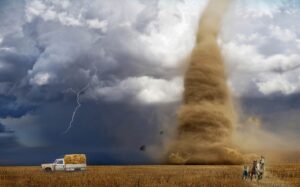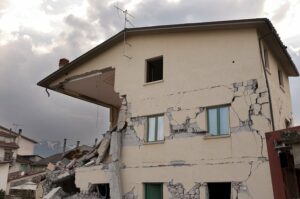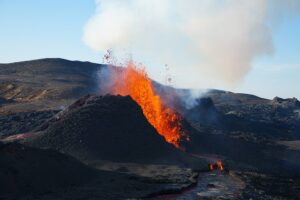Radiant energy is a form of energy transferred by the means of electromagnetic radiation. The radiation energy is also converted into other forms. Let us study the example of radiant energy to kinetic energy.
- Windmill
- Steamboats
- Tornadoes
- Trains run by steam
- Dust particle carried by the wind
- Fan causing the motion of the lighter object
- Rocket
- Cyclone
- Earthquake
- Volcanic eruption
- Demolition of building
- The heat emitted by the hairdryer
- Water bird toys
Detailed Explanation on the example of radiant energy to kinetic energy
Radiant energy is radiated in the form of light, heat and sound. In some cases, radiant energy causes motion; the example of radiant energy to kinetic energy is explained below.
Windmill
The wind carries radiant energy. When the wind blows, the radiant energy is carried through the wind that causes the wings of the windmill to rotate. Since the rotation of the wings is a form of kinetic energy, the radiant energy is transformed into kinetic energy.

Steamboats
Steamboats are run by steam produced by burning coal. When the coal is burnt, heat is radiated, and the water boils, producing steam. The steam generates the pressure to push the piston, and thus the boat begins to move. Thus the radiant energy from the coal is turned into the kinetic energy of the boat in motion.
Tornadoes
During summer days, we have observed tornadoes. When the humid, warm air and the dry cold air collide, tornadoes are generated. The air radiating from the tornadoes attracts the particles in the surround, and it begins to rotate. Thus the surrounding particles acquire kinetic energy from the radiated air.

Trains run by steam
A steam train also works similarly to steamboats. Heat is radiated by burning the coal produces steam. As the burning increases, the steam temperature also creases, creating high pressure. The pressurized steam pushes the axel of the piston connected to the wheel, causing them to rotate, and thus the train begins to move. Therefore trains run by steam are an example of radiant energy to kinetic energy conversion.
Dust particles carried by the wind
The wind always blows from region of low-pressure to high-pressure or vice versa. It is a good example of radiant energy to kinetic energy conversion. The breeze carries the dust particle with it when it blows. The dust particles possess kinetic energy as they begin to move. The radiant energy carried by the wind is transferred to the dust particle to cause motion.
Fan causing the motion of the lighter object
When you switch on your fan for some air, the object lighter object near the fan moving in the air is an example of radiant energy to kinetic energy. When the fan is turned on, the mechanical energy makes the propellers rotate and thus, the air is radiated in the room. The objects less dense than the air begins to move; thus, radiant energy emitted by the fan is converted as the kinetic energy of the lighter object.
Rocket
The rocket launching requires more amount of fuel to be ignited. The burnt fuels produce a large amount of radiant energy in the form of heat. Thus to escape from the earth’s gravity, upward thrust must be very high; it is given by the fuel radiated downward when ignited. Thus vertical motion of the rocket is due to the radiant energy which is radiated downward.

Cyclone
Cyclones are caused due to rise in the temperature of the air over the ocean surface and a fall in the atmospheric pressure in that region. The air in the surrounding region is of high pressure, which is pushed towards the low-pressure area, and thus the air is warmed up. This results in the water molecule acquiring kinetic energy, and it rises. This cycle is continuous.
During cyclones raining is common, it is because the cool air becomes warm and moist due to low pressure, it rises. When the warm air rises up, the atmospheric air cools them, and the cloud is formed, causing the rain.
Earthquake
When the seismic wave suddenly releases in the earth’s lithosphere, the surface of the earth is shaken causing the earthquake. The seismic wave radiated hits beneath the surface causing the vibration, which shakes the surface.

If the frequency of a seismic wave is more, it causes the collapse of buildings, cracks in the surface.
Volcanic eruption
When a rock called magma beneath the earth rises to the surface, volcanoes erupt. When the earth’s mantle melts, it radiates a tremendous amount of energy, causing high pressure in the exsolved gases in the magma. Magma is lighter, and thus pressure created pushes the magma to rise out of the surface, causing the eruption.

Demolition of building
In the process of demolition of large buildings, a vibration of significant frequency is radiated on the walls of the building, causing the destruction. Explosives like dynamites are used in this process. The vibration radiated by the dynamite hits the wall of the building; this vibration makes the building collapse.
The heat emitted by the hairdryer.
To dry the wet hair, hairdryers are used. The hairdryer radiates the heat. When we blow them on our hair, the hair becomes dry, and we can also observe the spreading of the hair in the air. Thus radiant energy from the dryer is transferred to the hair as kinetic energy.
Water bird toys
The water birds are perpetual motion toys that work as heat engines to mimic the motion of the drinking bird. When the bird’s beak dips in the water, the water is vaporized in the bird’s head and radiates heat. This radiated heat lowers the pressure and makes the head toggle. Thus radiated energy is converted as kinetic energy.
Also Read:
- Conservation of mechanical energy examples
- Example of kinetic energy to light energy
- Example of potential energy to sound energy
- Mechanical energy examples
- Example of chemical energy to kinetic energy
- Example of chemical to mechanical energy
- Example of potential energy to thermal energy
- Example of radiant energy to electrical energy
- Example of mechanical to electrical energy
- What is the kinetic energy of light
I am Keerthi K Murthy, I have completed post graduation in Physics, with the specialization in the field of solid state physics. I have always consider physics as a fundamental subject which is connected to our daily life. Being a science student I enjoy exploring new things in physics. As a writer my goal is to reach the readers with the simplified manner through my articles.
